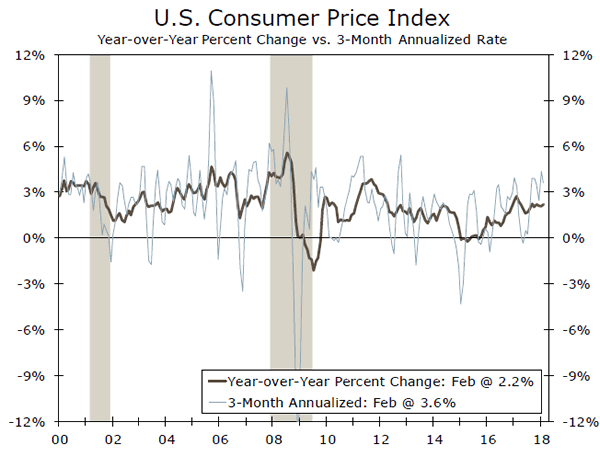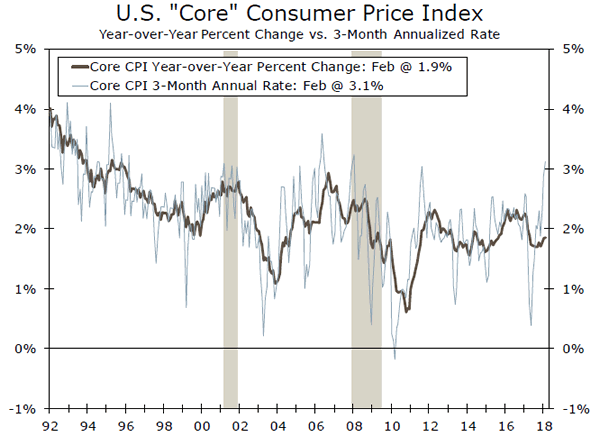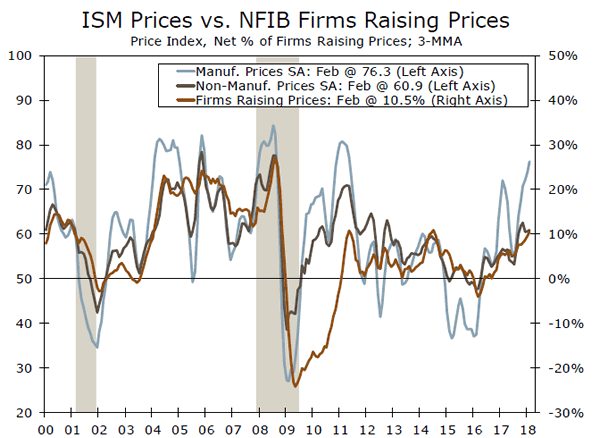Coming on the heels of a strong January, headline and core CPI both rose 0.2 percent in February. CPI is now up 2.2 percent over the past year, while over the past three months, core CPI is up at a 3.1 percent annual pace.
Inflation Moderates Only Somewhat After Strong January
Following a 0.5 percent increase in January, consumer price inflation moderated only slightly in February and advanced 0.2 percent. That pushed the one-year change in the CPI index up to 2.2 percent.
Energy prices were only a small factor this month, up 0.1 percent. The small gain was driven entirely by higher costs for energy services as utility gas services rose nearly 5 percent. Gasoline prices were down 0.9 percent after seasonal adjustment. Food prices were flat as the 0.2 percent decline in food at home was offset by the same sized gain in prices for food away from home.
Core Still Warm After a Hot January
After the strongest monthly gain in 10 years, core inflation posted another solid print in February. Excluding food and energy, prices rose 0.2 percent. Goods prices rose for a third consecutive month (up 0.1 percent) largely due to another impressive gain in apparel prices. Apparel prices rose 1.5 percent on the heels of a 1.7 percent gain in January, making that the biggest two-month change in the index since 1990. A number of other major categories of core goods, however, fell over the month, including new and used vehicle prices and medical goods. Core services also moderated (up 0.2 percent) on slower growth in housing costs and flat prices for medical services, although the costs of transportation services picked up.
Trending Higher
The year-ago change in the core index was steady at 1.8 percent. Even with February’s more modest print, the recent trend is higher. Over the past three months, core inflation has risen at a 3.1 percent annualized pace—the fastest of this expansion. The stronger trend should be more evident in the March data released next month. Last year’s run of monthly declines in wireless services reached a nadir in March, which led to a rare monthly decline in the core index. Even a small gain (as little as 0.2 percent) would push the 12-month change back to 2.0 percent (after rounding).
More broadly, price pressures are increasing. The latest ISM survey shows manufacturers seeing input costs increase at the fastest pace in seven years. Non-manufacturers have also increasingly reported costs rising in recent months, with the prices paid index above 60 in five of the past six months. This morning’s separately released NFIB survey showed the share of small businesses raising prices in February matching the expansion high of 13 percent. While tariffs have been in the limelight in recent weeks, we do not foresee them as becoming a significant driver of inflation unless measures escalate, and expect the FOMC to be similarly unfazed. Even without tariffs, however, the trend in inflation is clearly moving upward, which will likely affirm the FOMC’s plans to continue raising rates this year.















